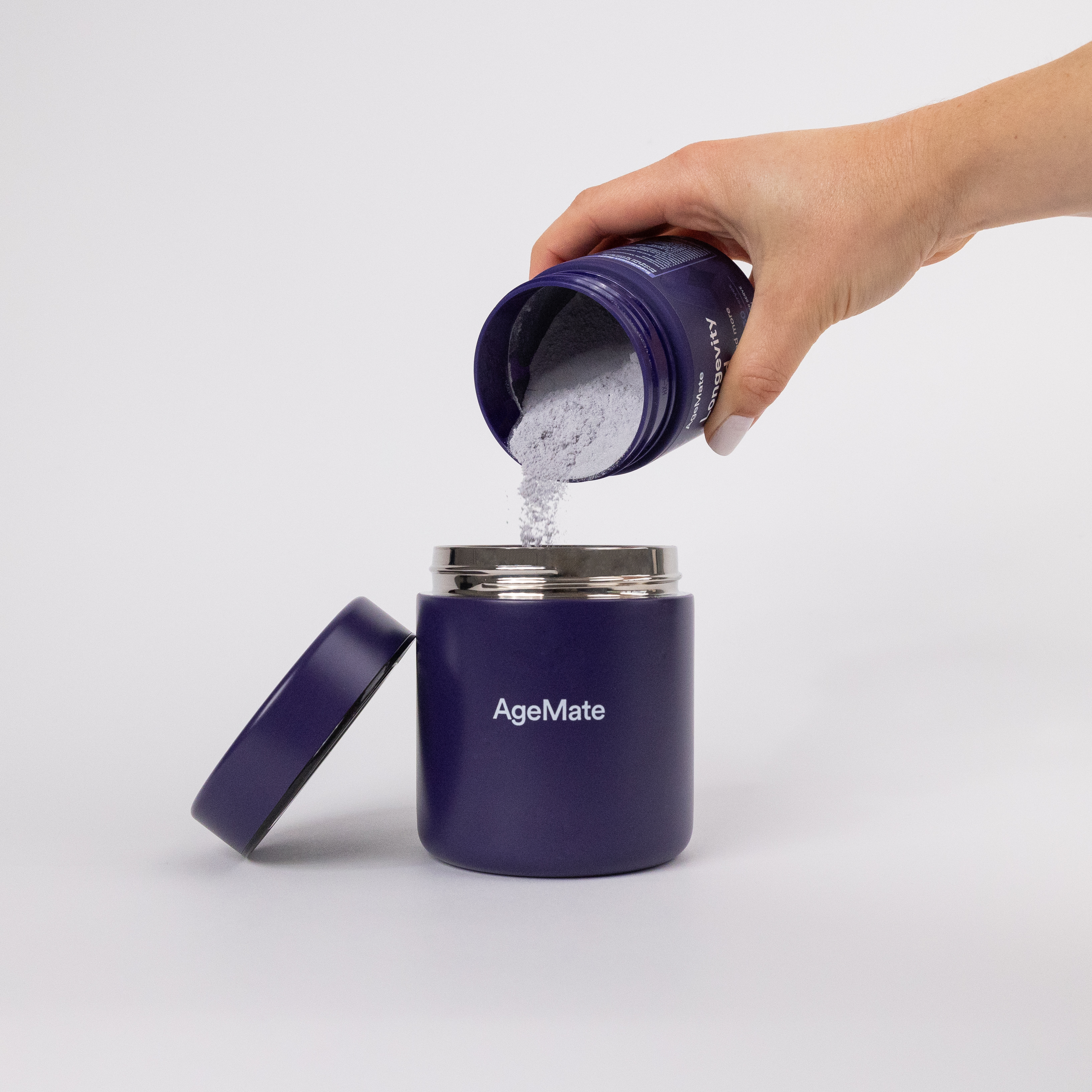Fasting may slow aging, improve lifespan and healthspan, and reduce age-related degeneration. What’s the best fasting method, though — particularly for longevity? In this article, we’ll be taking a closer look. We’ll also be diving deep into several of the most popular types of fasting.
When (and how much) to eat?
Most people today eat more calories than their bodies need, leading to insulin resistance, weight gain, and mitochondrial dysfunction.
While simply eating less is a viable solution, this is easier said than done. At least if you take the conventional route of just trying to eat smaller portions. Trying to calorie restrict can lead to hunger, cravings, and spending inordinate amounts of time thinking about food . . . especially in the long run.
A far easier way of eating less can be found through fasting. Fasting can easily be used to lower your daily/weekly calorie intake without experiencing undue hunger. Fasting allows one to get the best of both worlds: occasional big meals, and occasional calorie restriction. (This is especially true of intermittent fasting, but more on that later.) The big meals are satiating, while the calorie restriction offers all sorts of longevity-enhancing benefits. [1]
If you’re wondering about fasting and weight loss, we have more good news: many people find that fasting makes weight loss easier. People also tend to notice that fasting preferentially burns fat, not muscle, leading to improved body composition.
Fasting vs. calorie restriction
Before we dive any deeper into the best fasting methods, we should make an important distinction: fasting and calorie restriction aren’t necessarily the same thing.
Fasting refers to limiting calories for specific time periods, while calorie restriction means limiting calories throughout the day/week. The boundaries can get blurred, though, as many people who fast also restrict calories — and vice-versa.
People who want to fast without losing weight can simply eat more calories before and/or after their fast. Fasting and weight loss often go hand in hand, but they don’t have to.
What’s the best fasting method?
When it comes to fasting, there’s more than one way to trim the fat. Many people prefer intermittent fasting, also known as IF, which calls for restricting your meals to a set eating window (usually an 8-hour window) each day. Most people who practice IF opt to eat two big meals within this eating window.
In a practical sense, the best fasting method is whatever method allows you to avoid excess hunger and stay energised. Let’s take a look at some of the most popular fasting methods and their pros and cons below.
Different forms of fasting and circadian eating plans
Intermittent fasting (technically speaking, it’s probably not what you think)
Intermittent fasting is the most popular form of fasting around today. Many people consider IF the best fasting method, too. Popularised by a bodybuilder named Martin Berkhan more than a decade ago, IF has broken through into mainstream consciousness over the last few years. Most forms of IF feature a 16:8 cycle: 16 hours of fasting, then 8 hours of eating. This 24-hour cycle is then repeated each day. Simple and effective, intermittent fasting is often as easy as just cleaning up your snacking and skipping breakfast.
Research shows that IF may:
- Flip the metabolic switch onto fat burning
- Re-optimise hormone levels
- Support mindful eating
- Accelerate weight loss
Time-Restricted Eating
Time-restricted eating (also called time-restricted feeding or time-restricted fasting) refers to eating within a specific daily time window. You might say that IF and its 16:8 cycle is a type of time-restricted eating. Other types of time-restricted eating include:
- 23:1
- 22:2
- 18:6
- 14:10
As you can see, all sorts of options are available. Some people do best with the OMAD (one meal a day) diet and its 23:1 cycle . . . others enjoy milder forms of time-restricted eating like 14:10. Athletes, women, and people who are naturally thin are likely to do best with milder forms of fasting.
Research shows that time-restricted eating can cause weight loss — even when no dietary changes are made! A 2021 study found that eating within a specific time window caused weightloss of up to 8% over 8 weeks. And results got even better at the 12-week mark. [2]
Wondering where to place your eating window? Other research shows that timing matters, too. One study found that ending your eating window earlier may improve insulin sensitivity, an important metric in body composition. In theory, eating within a 5-hour window from 2-7 pm might be more effective than eating within a 4-hour window going from 4-8 pm. [3]
One-day fasting
One-day fasting involves going exactly one day without eating. You might have a final meal Friday night, go all day Saturday without eating, then break your fast Sunday morning. Intuitive enough, right?
There are several variations of one-day fasting. Most people do one-day fasts once or twice a week, but all you fasting enthusiasts out there can take things a step further:
- Alternate-day fasting (ADF): eating every other day
- The 5:2 diet: doing 2 one-day “modified fasts” each week
- Eat stop eat: a stricter version of 5:2 fasting
Multiday fasting (sometimes also called prolonged fasting)
You can take your fasting routine even further by fasting for more than one day in a row. Some enthusiasts enjoy fasting the last three days of every month, the first week of every year, et cetera — the possibilities are endless.
And don’t be concerned about the idea of such a long fast slowing down your metabolism.
Occasional fasting may actually boost your metabolic rate by upregulating fat-burning hormones like norepinephrine.
While more research is still needed, one study found that fasting for 3 days boosted metabolism by up to 14%. It’s likely that long-term calorie restriction is what causes metabolic slowdown. Fasting? Not so much. [4]
Fasting: Many Types, Many Benefits
Regardless of which type of fasting you decide to incorporate into your life, you can be sure of one thing: fasting is associated with all sorts of health benefits. At the heart of these benefits is fasting’s ability to coax your body to burn fat, not glucose, for fuel. Fasting essentially flips the metabolic switch.
A 2020 study described this metabolic switch this way: “[going] from using glucose as energy to using fatty acids and ketones for energy is called intermittent metabolic switching”. [5]
Fasting can also boost your brain’s ketone levels, resulting in a steady stream of high-octane mental energy. This is especially true of multiday fasts. More ketones mean greater metabolic efficiency and increased energy production. Interestingly enough, many of fasting’s best effects may be independent of weight loss. They may come primarily from this metabolic shift away from overreliance on carbs and towards ketones
Fasting may also improve health and longevity by upregulating your body’s NAD+ levels. Both fasting and long-term calorie restriction can have this effect.
Learn more about the interplay between NAD+, NMN, and longevity here.
Fasting: how to fast well
Now that we’ve covered some of the top fasting techniques, let’s look at how to tailor your fasting routine to longevity. While almost every type of fasting is likely to improve metabolic health enough to support lifespan and healthspan, there are also some key considerations to keep in mind:
- Fasting activates autophagy or cellular recycling. This may reduce inflammation, oxidation, and your overall rate of aging. [7]
- Even very short fasts (think 12 hours) may improve metabolism, cellular regeneration, insulin sensitivity, genetic expression, and more. [8]
- More consistent alternate-day fasting may extend lifespan by up to 80+ percent — at least in lab rats. [9]
What’s the best fasting method for longevity?
Now for the most important question of all: what’s the best fasting method for optimising healthspan, lifespan, and longevity? Some experts believe a seasonal approach is best. Consider fasting for 3-4 days at the start of every season. (If you’re also fasting for weight loss, feel free to do fasts of this length once a month.) A 3+ day fast allows you to clean out cellular junk, enter ketosis, trigger stem cells, and activate your immune system.
Shorter fasts are also good, but they probably don’t trigger cellular recycling to the same degree. To really slow the aging process, you may need to do the occasional long fast. Here’s what to expect as you get started.
The first 5 hours
This might seem surprising, but the first 5 hours of a long fast might be the hardest. By the end of this period your blood sugar will have probably dipped, and your cells probably won’t be burning fat yet. Translation: don’t be surprised if you start getting hungry.
5 to 24 hours after your last meal
Think of this period as the transition zone. Your blood sugar will have reached its lowest point, triggering your body to start breaking down triglycerides (stored fats) into highly absorbable free fatty acids. You may get a slight adrenaline rush near the end of this period, especially if you’ve done long fasts in the past.
1-3 days after your last meal
Ketosis tends to kick in at this stage. What’s ketosis, you ask? A special metabolic state where cells transition to using ketone bodies for energy. Think of ketone bodies as the perfect slow-burning fuel. Made from free fatty acids, ketones provide your body with highly efficient fuel.
Ketones are associated with a variety of health benefits, too. They may reduce inflammation, improve mental performance, and trigger the growth of new neurons. Ketones are largely responsible for the energy boost that comes when you break through the initial ‘hunger stage’ of fasting.
3 days after your last meal
By this point you’ll be deeply into ketosis. (If you have a ketone meter, don’t be surprised to see beta-hydroxybutyrate ketone levels of around 1.5-3 mM.) You’ll also begin activating autophagy, or cellular recycling, in response to the absence of cellular energy intake.
Your body will have acclimated to fasting by this point, too. Expect drastically less hunger, courtesy of consistently low levels of insulin and hunger hormones like ghrelin. Stem cell production should start really ramping up by day 3.
These positive internal changes can begin to cause external changes. Some people notice undereye bags, fine lines, and skin discoloration beginning to fade. (These initial changes are probably caused by upregulated growth hormone production.)
Water retention is normalised, too, causing you to look leaner and younger. Last but not least, your body’s endotoxin production may go down, leading to smoother skin and a healthier glow. You’ll basically be aging in reverse!
Can fasting be unhealthy?
While fasting is indeed excellent for anti-aging, it’s not always for everybody. Too much fasting may lead to unwanted side effects . . .
Muscle wasting
Excessive fasting may trigger muscle loss, particularly for those who metabolise food quickly. Stick with IF and other more moderate methods if you’re prone to losing muscle. 16:8 Intermittent fasting can actually have an anabolic effect.
Nutrient deficiencies
Fasting may also aggravate underlying nutrient deficiencies. For this reason, it’s important to choose the best possible foods during your eating windows. Select foods that are high in nutrients and low in anti-nutrients. If you go into a fast, healthy, and nutrient-replete, you’ll come out of it even healthier.
Supplementation may be a good idea in the case of hard-to-get nutrients like magnesium and vitamin K2. You can also supplement with branched-chain amino acids if muscle loss is a concern.
Unwanted weight loss
Related to unwanted muscle loss, unwanted weight loss can also affect those who burn through energy quickly. Intense practices like ADF (alternate day fasting) may be too much too soon for those who don’t need to lose excess weight. As we said earlier, those of you who are already at your goal body composition can feel free to stick with milder forms of intermittent fasting.
Unwanted stress
Chronic stress is never a good thing. If your body is already stressed out by illness, nutrient deficiencies, or overwork, you may want to hold off on extended fasting. Why? Because fasting itself is a type of hormetic stressor. Normally the body can adapt to and overcome this type of stress, but not if it’s overly stressed already!
Fasting for females
Research shows that women respond differently to fasting than men. More sensitive to energy and nutrient flux, they tend to do better with short fasts followed immediately by energy replenishment. One study showed that intense fasting actually decreased insulin sensitivity in women. Women are also more sensitive to deficiencies in iron than men are.
In theory fasting is fine if you can eat enough nourishing food within your eating windows — but this is only in theory. Be sure to listen to your body before partaking in any long fasts.
One more thing: women who are nursing, pregnant, or wanting to become pregnant should definitely avoid fasting. These energy-intensive processes should be fed by plenty of healthy fats, calories, and nutrients. You’ll have plenty of other times to fast, but this isn’t one of them! [10]
Taking specific medications
Certain medications, especially heart medications, can deplete your electrolyte levels enough to make them (potentially) incompatible with fasting. Why’s that? Because traditional water-only fasting doesn’t include any electrolyte consumption. You may be able to mitigate this problem by supplementing with electrolytes during your fast. Even more importantly, be sure to talk to your doctor before fasting if you’re on heart meds.
Is fasting for me?
If you want to:
- Lose weight
- Build muscle
- Improve your fitness
- Delay the aging process
…then fasting is probably for you.
Fasting may not be ideal, however, if you are:
- Thin/underweight
- Struggling with chronic disease
- Taking medication for a heart condition
- Nursing, pregnant, or trying to become pregnant
- Under 25 years old
How to make fasting even more effective
Fasting is amazing — if you do it properly. Here are some quick tips to make your fasting routine even more effective.
Go ketotic quick
Much of the hunger and tiredness you may encounter on day 1 of a long fast can be avoided. How? By getting into ketosis as quickly as possible. Experts like Dr. Dominic D’Agostino advocate for beginning your fast with a trifecta of caffeine, MCT oil, and gentle endurance exercise. (More on the benefits of MCT oil later.) You might kick off your first day of fasting with MCT oil-infused coffee and a long walk, swim, or hike. This will allow you to access fasting’s best benefits sooner, all while minimising hunger and other unwanted side effects of fasting.
Take electrolytes
Electrolytes — sodium, potassium, magnesium, and calcium — are needed for your body to function at its best. Electrolytes are critical for keeping your nerves conductive and your muscles under the control of your mind.
Supplementing with electrolytes can also reduce some of fasting’s initial side effects. If you’re experiencing fatigue, cramps, brain fog, or light-headedness during the initial days of your fast, electrolytes may be an all-natural solution. Consider the following daily dosages to optimise your next fast:
- Magnesium: ~500 mg
- Calcium: ~1,000 mg
- Sodium: ~2,000 mg
Conclusion
Regardless of the type of fasting you settle into, fasting remains an incredible way to help us with healthy aging, reduce your risk of age-related diseases, and improve your overall quality of life.
Humans were never made to have access to food 24/7. Occasional fasting presents you with the opportunity to detox from food toxins and tap into something primordial. It allows you to access the most efficient metabolic pathway of all, ketosis, and fuel both body and mind.





